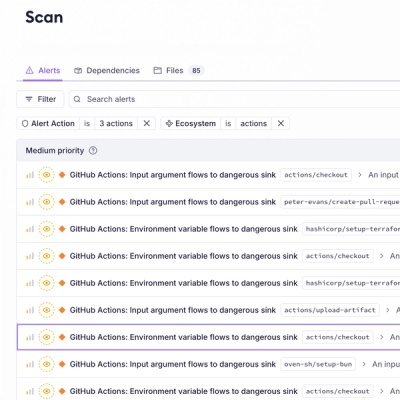
Product
Introducing Socket Firewall Enterprise: Flexible, Configurable Protection for Modern Package Ecosystems
Socket Firewall Enterprise is now available with flexible deployment, configurable policies, and expanded language support.
@times-components/ssr
Advanced tools
The renderer used to render top level components server side and to create client bundles. Add any "pages" (top level components) here for rendering, by adding a route and the webpack config necessary to create a client bundle.
The renderer used to render top level components server side and to create client bundles. Add any "pages" (top level components) here for rendering, by adding a route and the webpack config necessary to create a client bundle.
In order to create a bundle, we need for all packages to have their own rnw bundle.
Use npx lerna run bundle at the root to simulate a published package.
yarn bundle:dev
Create a client-side dev bundle to hydrate the SSR page, useful for checking developer level warnings which you may need to fix
yarn bundle:prod
Create a client-side prod bundle to hydrate the SSR page, this will have the various optimisations applied with code splitting and silence any console warnings/errors. The server-side response is also compressed for testing client perf.
GRAPHQL_ENDPOINT=<API endpoint> SPOT_ID=<SpotIM ID> yarn start
Run a simple node server which serves up the various pages which currently include:
/article/:article-id/profile/:author-slug/topic/:topic-slugThey will use the client side bundle you generated above.
GRAPHQL_ENDPOINT is used for data fetching.SPOT_ID is used to render comments on article pages.GRAPHQL_TOKEN (instructions should be available from your
API provider) to get unteased articles.yarn bundle:profile
This will generate the webpack stats.json file in dist. You can then use a
command such as npx webpack-bundle-analyzer stats.json in the dist folder to
visualise the webpack bundle or upload it to other tools
suggested by webpack
yarn start:testserver
Simply starts the SSR server but sets the SPOT_ID to a fixed dummy value (so
the SpotIM script will written on the article page, but not found/run), and sets
GRAPHQL_ENDPOINT to port 4000 which is where the test TPA server should be running.
Please read CONTRIBUTING.md before contributing to this package
Please see our main README.md to get the project running locally
The code can be formatted and linted in accordance with the agreed standards.
yarn fmt
yarn lint
As the future of the website, we want to improve the end-to-end testing DX which Cypress may help us with. There is currently a very simple implementation which could be developed to the point where editorial content is developed with a TDD approach here, that just happens to use components in the monorepo.
Currently there is one simple test that is run separately in CI with no coverage measured.
The tests can be developed as follows:
yarn start:testservers
npx cypress open
you can then use the Cypress GUI to develop your tests.
For CI or to check you haven't broke anything there is:
yarn test:integration
This will create a dev client side bundle with the mock GRAPHQL_ENDPOINT,
start up the mock server and SSR, run the Cypress tests inside electron and
then shutdown the servers.
To enable persisted queries in the client, add the following line to your client-side javascript:
window.nuk.graphqlapi.usePersistedQueries = true;
Publish : potentially we want to look at using this as our source of truth for server-side rendering, this would mean exporting and publishing the code to be used by render, so it's "all the same code"
Bundle Size: we bundle packages on CI in master, we could then bundle here and lint for excessively sized bundles
Testing: flesh out the mock server to auto-generate several scenarios for e2e testing and add more Cypress tests to move away from render specific and/or Java tests
FAQs
The renderer used to render top level components server side and to create client bundles. Add any "pages" (top level components) here for rendering, by adding a route and the webpack config necessary to create a client bundle.
The npm package @times-components/ssr receives a total of 16,438 weekly downloads. As such, @times-components/ssr popularity was classified as popular.
We found that @times-components/ssr demonstrated a healthy version release cadence and project activity because the last version was released less than a year ago. It has 3 open source maintainers collaborating on the project.
Did you know?

Socket for GitHub automatically highlights issues in each pull request and monitors the health of all your open source dependencies. Discover the contents of your packages and block harmful activity before you install or update your dependencies.

Product
Socket Firewall Enterprise is now available with flexible deployment, configurable policies, and expanded language support.

Security News
Open source dashboard CNAPulse tracks CVE Numbering Authorities’ publishing activity, highlighting trends and transparency across the CVE ecosystem.

Product
Detect malware, unsafe data flows, and license issues in GitHub Actions with Socket’s new workflow scanning support.